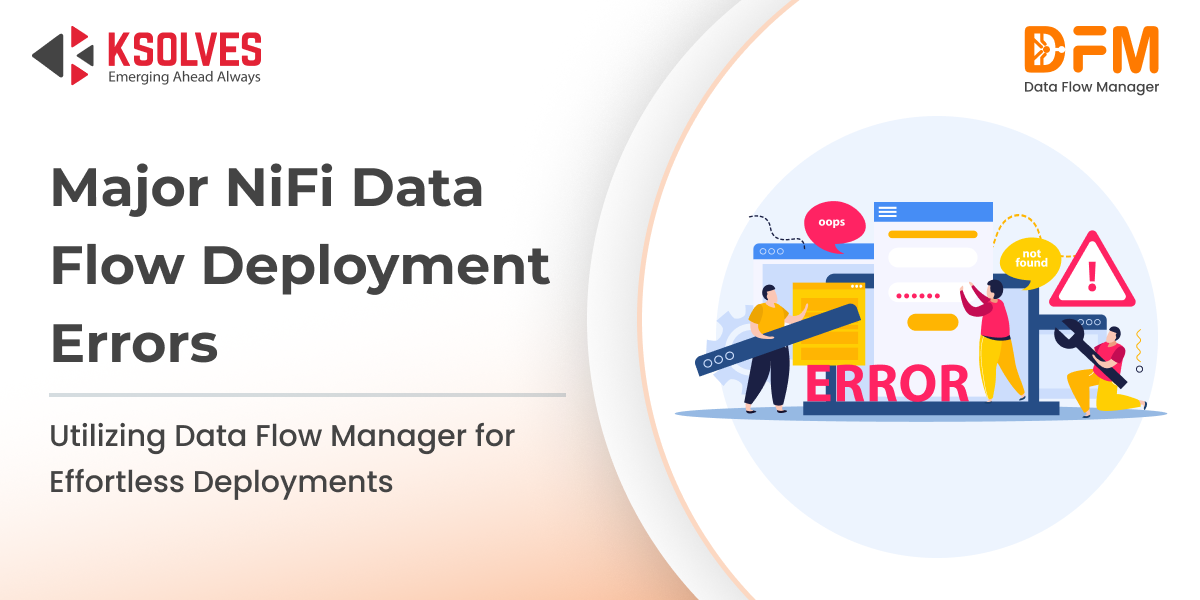Common Errors in NiFi Data Flow Deployment and How Data Flow Manager Overcomes Them
![]()

Are you deploying your data flows across NiFi clusters manually?
If yes, you’ve likely encountered some common challenges—version mismatches, incorrect parameter contexts, inconsistent flow file attributes, and more. These deployment errors can lead to processing failures, data loss, and operational inefficiencies, making it crucial to address them effectively.
Deploying data flows across NiFi clusters might seem straightforward, but in reality, even small misconfigurations can lead to major disruptions.
This blog explores the most common NiFi flow deployment errors, their impact on data operations. It walks you through how Data Flow Manager, built for an on-premise environment, simplifies the process by automating flow deployments, ensuring consistency, and eliminating human errors.
6 Common Errors in NiFi Data Flow Deployment
1. Version Mismatch Across Clusters
One of the most frequent issues in NiFi flow deployments is version inconsistency across clusters. Different versions of processors, controller services, or configurations can create compatibility issues, leading to unexpected failures.
What happens? A flow that works seamlessly in one environment might break in another due to deprecated or missing components.
Impact: Inconsistent data processing, duplicated or missing records, and debugging headaches.
2. Incorrect Parameter Contexts
NiFi Parameter Contexts store crucial environment-specific values, such as database connection strings, API keys, and authentication credentials. If these parameters aren’t properly configured, deployments can fail.
What happens? When moving a data flow from one environment to another, missing or incorrect parameters can disrupt connectivity.
Impact: Broken integrations, unauthorized access attempts, and security vulnerabilities.
3. Missing or Incorrect Dependencies
NiFi processors often rely on external libraries, scripts, and configurations to function properly. If these dependencies are not correctly configured across environments, workflows may stop unexpectedly.
What happens? A processor fails to start, causing downstream workflows to stall.
Impact: Failed processing, incomplete data flows, and manual intervention to restore missing components. This can disrupt real-time data streaming and increase operational overhead.
4. Inconsistent Flow File Attributes
Flow file attributes carry metadata that determines how data is routed and processed. If these attributes change between deployments, due to manual updates or system variations, data may be misrouted or lost.
What happens? Data ends up in the wrong destination or is transformed incorrectly.
Impact: Incorrect data transformations, routing errors, and dropped messages. This can result in faulty analytics and poor decision-making based on incomplete or inaccurate data.
5. Incorrect Permissions & Access Control
Security policies and authorization settings determine which users or processes can access different components of NiFi. Misconfigured permissions can either prevent workflows from executing or expose sensitive data to unauthorized users.
What happens? A restricted user tries to update a flow but gets denied, or worse, an unauthorized user gains access to sensitive data.
Impact: Unauthorized access, compliance violations (e.g., GDPR, HIPAA breaches), and broken workflows due to blocked access. This increases security risks and regulatory liabilities.
6. Inefficient Load Balancing & Cluster Coordination Issues
When working with multiple NiFi nodes or clusters, failing to distribute the processing load properly can lead to bottlenecks. Some nodes may be overloaded, while others remain underutilized.
What happens? Heavy traffic on one node slows down processing, while other nodes remain idle.
Impact: Slower processing times, increased latency, resource exhaustion, and potential downtime. This affects real-time data processing and can cause delays in critical workflows.
Business & Operational Impact of NiFi Flow Deployment Errors
Beyond technical failures, these deployment errors have significant business consequences that can affect operations, compliance, and customer experience.
1. Data Loss and Corruption
When errors occur in NiFi flow deployments, data may be lost, duplicated, or corrupted. This affects downstream analytics, reporting, and decision-making processes.
Example: A retail company using NiFi for real-time inventory updates may experience stock discrepancies due to missing transactions, leading to overstocking or stockouts.
2. Downtime & Reduced System Reliability
When deployments fail, diagnosing and fixing issues takes time. This downtime can disrupt business operations, especially for real-time data-driven applications.
Example: A financial services company using NiFi for fraud detection may experience delays in identifying fraudulent transactions, increasing financial risks.
3. Compliance & Security Risks
Mishandled access controls or configuration errors can expose sensitive customer data, violating industry regulations such as GDPR, HIPAA, or SOC 2.
Example: A healthcare provider using NiFi for medical record processing could face regulatory fines if patient data is exposed due to misconfigured permissions.
4. Increased Operational Costs
Fixing deployment issues requires time, skilled personnel, and additional resources, driving up IT costs and reducing overall efficiency.
Example: A cloud-based analytics firm may need to allocate dedicated teams for troubleshooting and manual deployments, increasing operational expenses.
5. Poor Customer Experience
Data processing delays and failures can directly impact customer satisfaction. If businesses rely on real-time data for user-facing applications, any disruption can lead to frustration and revenue loss.
Example: An e-commerce platform using NiFi for order fulfillment may experience shipping delays if real-time updates fail, leading to customer dissatisfaction and lost sales.
How Does Data Flow Manager Address These Common NiFi Flow Deployment Errors?
Data Flow Manager is a powerful tool to deploy and promote data flows across multiple NiFi clusters on-premises. It eliminates the hassle of manually exporting and importing data flows from the source cluster to the target cluster using the NiFi UI.
You can deploy data flows in just a few minutes. Moreover, it provides the flexibility to edit flow configurations, such as variables, parameters, and controller services on the go. So you don’t have to worry about any misconfigurations or inconsistencies in data flows.
Note: To use Data Flow Manager, you must have your NiFi clusters onboarded to the tool. If not, that’s very easy – just fill in a few details of the cluster and effortlessly onboard it to Data Flow Manager.
Want to see how Data Flow Manager simplifies the deployment of data flows across clusters? Watch this video:
https://www.youtube.com/watch?v=KecyJEqJtnk
Some other game-changing features include:
- AI-Powered Data Flow Generation
- Flow Performance and Structure Analysis
- Schedule Data Flow Deployment
- Audit Logs for Data Flow Deployment
- Version Control & Rollback
- Role-Based Access Control
Conclusion
Deploying data flows across NiFi clusters can be complex, and even minor errors can lead to data loss, downtime, and increased operational costs. Issues like version mismatches, incorrect parameter contexts, missing dependencies, and inefficient load balancing can disrupt workflows and impact business outcomes.
Data Flow Manager simplifies and automates this process, ensuring accurate, secure, and hassle-free deployments in minutes. By eliminating manual errors, enhancing security, and optimizing resource allocation, Data Flow Manager transforms NiFi flow deployment into a seamless experience.
If you’re looking for a faster, error-free, and scalable way to deploy NiFi flows, it’s time to explore Data Flow Manager!
![]()

